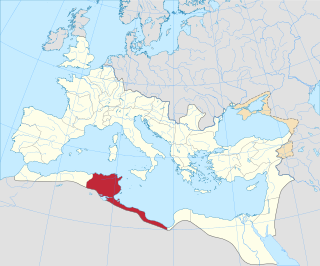
Afufenia (also called Afufeniensis) was a Roman era city in the province of Byzacena. Its exact location is unknown, but it would have been situated in central Tunisia.

The Roman Empire was the post-Roman Republic period of the ancient Roman civilization. It had a government headed by emperors and large territorial holdings around the Mediterranean Sea in Europe, North Africa, and West Asia. From the constitutional reforms of Augustus to the military anarchy of the third century, the Empire was a principate ruled from the city of Rome. The Roman Empire was then divided between a Western Roman Empire, based in Milan and later Ravenna, and an Eastern Roman Empire, based in Nicomedia and later Constantinople, and it was ruled by multiple emperors.

In the history of Rome, the Latin term civitas, according to Cicero in the time of the late Roman Republic, was the social body of the cives, or citizens, united by law. It is the law that binds them together, giving them responsibilities (munera) on the one hand and rights of citizenship on the other. The agreement (concilium) has a life of its own, creating a res publica or "public entity", into which individuals are born or accepted, and from which they die or are ejected. The civitas is not just the collective body of all the citizens, it is the contract binding them all together, because each of them is a civis.

In Ancient Rome, a province was the basic and, until the tetrarchy, the largest territorial and administrative unit of the empire's territorial possessions outside Italy. The word province in Modern English has its origins in the Latin term used by the Romans.
Afufenia was also the seat of an ancient Catholic bishopric. [1] [2] and was mentioned by Optatus. [3] One bishop is known from Afufenia, [4] Mansueto, who was among the Catholic bishops summoned to Carthage in 484 by the Vandal king Huneric and then exiled. According to Mesnage [5] it would be the same Mansueto remembered by Vetus Romanum Martyrology as of September 6. Today Afufenia survives as a titular bishopric, [6] with the current bishop being Raúl Alfonso Carrillo Martínez, Vicar Apostolic of Puerto Gaitán. [7] He replaced Paul J. Bradley in 2004.

Saint Optatus, sometimes anglicized as St. Optate, was Bishop of Milevis, in Numidia, in the fourth century, remembered for his writings against Donatism.
A bishop is an ordained, consecrated, or appointed member of the Christian clergy who is generally entrusted with a position of authority and oversight.
Huneric or Hunneric or Honeric was King of the Vandal Kingdom (477–484) and the oldest son of Genseric. He abandoned the imperial politics of his father and concentrated mainly on internal affairs. He was married to Eudocia, daughter of western Roman Emperor Valentinian III (419–455) and Licinia Eudoxia. The couple had one child, a son named Hilderic.





